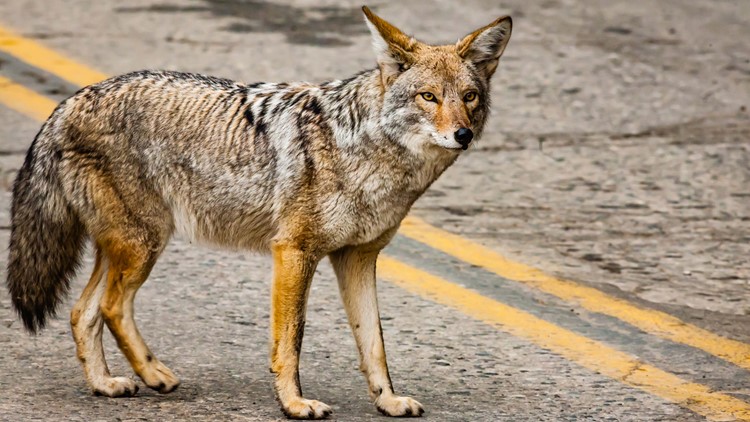ST. LOUIS — A pleasant evening stroll through the Spanish-inspired architecture of Country Club Plaza, in the heart of Kansas City, might lead one to contemplate which shops to explore for a unique gift. Dinner afterward offers a choice of world-class eateries to consider, or perhaps a stop for a latte at a trendy java shop.
Amid these musings, a peculiar, high-pitched sound suddenly emerges through the urban bustle — something between a yelp, a whine, a howl, and an eerie laugh — raising hairs on the back of the neck. It’s not at all something you would expect to hear.
Surely it can’t be. But it is. The call of a coyote.
Scenes like this are becoming increasingly possible and even common in Missouri’s metro areas. Coyotes, or Canis latrans as they are known in the scientific community, are moving in and taking up residence in cities across the state. It turns out that these creative canines take well to the urban lifestyle.
Joe DeBold is MDC’s urban wildlife biologist for the Kansas City region, and he’s seen video of coyotes captured by security cameras on Country Club Plaza.
“If they’re there, you know they’re pretty much everywhere, from dead center to the outskirts of town,” he said.
On the other side of the state, a coyote made an extended appearance in St. Louis City’s Tower Grove Park in the early months of 2010. It was dubbed “Gal” by popular media, and the Riverfront Times newspaper reported that the animal had its own Facebook page, boasting over 1,300 followers. Coyotes are routinely sighted all around St. Louis, like Forest Park and Wilmore Park, as well as Queeny and Jefferson Barracks county parks.
But why are coyotes moving into these urban environments? What draws them, and how can they survive in a place so alien to their traditional habitat? There are a couple traits that help coyotes fit in so well among humans.
COYOTES AREN’T PICKY EATERS
As omnivores, coyotes can sustain themselves on either plant material or meat. According to Tom Meister, MDC wildlife damage biologist for the St. Louis region, “Coyotes eat anything and everything and don’t have a specialized diet. They can adapt to their surroundings because they don’t mind eating whatever is available to them.”
DeBold agrees. “What’s being thrown at the coyote in urban areas is a giant buffet of prey. Within this urban area, you have a higher density of prey resources because people feed birds, squirrels, raccoons, and deer. This human feeding concentrates all these animals.”
DeBold added that the higher density of people in urban areas and large venues like sporting events can concentrate food sources such as litter and dumpsters, which can influence wildlife behavior.
A study by the Urban Coyote Research Program analyzed over 1,400 scat samples from urban coyotes and discovered the most common food items were small rodents, which made up 42 percent of their diet. Deer and rabbit contributed about 20 percent each. The study also revealed that fruits comprised about 23 percent of what coyotes ate.
Human garbage can also be a source of nutrition for coyotes. Meister explains that each generation of urban coyotes is being trained by their parents how to hunt and feed. “They get taught by their parents that garbage is put out on this street for Wednesday morning, so that’s where to eat Tuesday night,” he said.
COYOTES ARE SMART
Teaching their young brings up another trait coyotes possess — they are surprisingly intelligent and resourceful. DeBold says they’ve been referred to as the Einsteins of the wildlife community due to their remarkable ability to adapt to anything human society can throw at them. This intelligence allows coyotes to navigate and carve out territories from whatever patchwork of green spaces urban environments offer. These might include municipal parks, golf courses, cemeteries, storm water creeks, drainage ditches, suburban wooded common areas, and even subdivision yards. Meister said inventive coyotes can make their dens anywhere from tunnels under roads to holes dug in root wads.
Even houses and buildings aren’t necessarily a deterrent to resourceful coyotes. “It’s all structure, no different than a woodland,” said DeBold. “Coyotes weave in and out and between those houses and still feel secure in the dark. They don’t see it as a human home, they see it as a structure to walk around. It’s all within the hunt for them.”
PREVENTING CONFLICTS
Like any new neighbors, coyotes take some time to get used to. Fortunately, coyotes pose little threat to people. A 2009 study of coyote attacks on humans in the U.S. and Canada uncovered fewer than 150 such occurrences between 1960–2006. Most resulting injuries were minor, with just a single bite to the victim. About one-third of the incidents involved people feeding the coyotes. A minor portion of cases were connected to rabid coyotes, or coyotes that were cornered or protecting their den and pups.
One concern regarding coyotes is pets. Urban coyotes have been shown to predate on common housecats, which may seem more like natural prey, such as rabbits and squirrels. That may sometimes be the case with toy dog breeds like Pekinese, for example. Coyotes have been known to attack and kill small dogs, but Meister says it more often has to do with innate canine competition. The coyote may see a dog as an interloper on its territory. This is especially true if the dog is similar in size, like pointer and retriever breeds. Even smaller dogs, which can often have feisty or aggressive temperaments, can be perceived as threats if they charge or bark at a coyote.
Pet owners must be especially vigilant in areas where coyotes live. “The days of yesterday where you could just send your pet out the door and let it do its business for an hour is no longer,” said DeBold. “You go out there and be there with your cat or dog every time it goes outside, be right beside it. And that will most generally take away the threat. Because when coyotes attack a cat or dog, its usually not right at the feet of a human.”
Spring is a time to be extra vigilant. Coyotes typically breed in February and March. Females give birth to four or five pups about 60 days later. “Because food requirements increase dramatically during pup rearing, April through May is when conflicts between humans and urban coyotes are most common,” said Meister. At this time, coyotes are on the move more seeking food, and may act more aggressively toward any animal they see as potential competition, like family dogs. Meister says you can also help the situation by not offering things in your yard that might give coyotes a reason to come around.
“Remove attractors like garbage cans, pet food, apples and pears dropped from trees, pumpkins, even bird feeders,” he said. While birdseed itself is not enticing to coyotes, any rodents or squirrels the seed might also attract are top coyote prey. Installing a fence might also help. Fences should be at least 6 feet high and dug into the ground 6 inches deep, so the agile and resourceful canines cannot jump or dig under them.
Trapping or killing coyotes, however, has not shown to be successful. Traps designed to snare coyotes can likewise capture cats and dogs — or even children — making them unsafe for use in populated areas. Eliminating coyotes might even be counterproductive. Meister says research shows if a coyote is removed from a place where there’s food, water, and shelter, another will take its spot. Or, the population may even expand.
“If mom or dad are killed, they can’t control the young ones who may cause trouble and over breed,” he said. “With no dominant male or female to keep them under control, the problem could increase.” This could also cause a short-term surge in coyotes as the territory lines are redrawn by newcomers.
GOOD HARASSMENT MAKES GOOD NEIGHBORS
“Gal,” the Tower Grove coyote, may have had 1,300 Facebook followers, but MDC wildlife biologists say the best way to exist with coyotes is to “unfriend” them.
“The goal is to educate coyotes that they’re not welcome,” emphasized Meister. In other words, homeowners need to show some tough love.
Research has established that coyotes can successfully be conditioned to stay away through consistent harassment and hazing. Meister says homeowners should take every opportunity to instill fear of humans in coyotes. Anytime a coyote should approach or be seen in the yard, Meister suggests doing everything possible to make it a negative experience for the animal. This could include yelling or making other loud, threatening noises, throwing rocks and sticks, spraying high pressure garden hoses, or blowing air horns. Shaker cans filled with pennies, paintball guns, and fireworks (where permitted by local ordinances) can also be effective. If its encounter with humans is unpleasant, a coyote will be less likely to come back. The key is consistency, being visible, and making sure coyotes know that humans are the source of unpleasantness.
The City of Denver has reduced human-coyote conflicts by emphasizing hazing as the primary method for addressing coyote problems. Direct encounters between people and coyotes decreased more than 75 percent from 2009 to 2010, reported the Denver Department of Parks and Recreation.
HUMANS AND COYOTES LIVING TOGETHER
As coyotes adapt increasingly well to urban environments, it’s a simple fact coyotes are now part of the metropolitan wildlife scene, and they are likely there to stay. But it is possible for people and coyotes to successfully coexist. Meister even points out some benefits these canine neighbors can offer.
“They help keep wildlife populations in check, act as scavengers and remove dead animals, help control rodent populations, and even eat rabbits, which might be eating your garden,” he said.
The presence of coyotes in an urban area says something even more significant, though. According to DeBold, they can be an indicator species as to the quality of the green space around us.
“The coyote is one of those animals that if you have them in your environment and they’re healthy, you know that overall the environment has to be healthy, too. It’s a positive sign, just like seeing deer and songbirds.”
With that in mind, it would seem Gal’s Facebook likes were well-deserved.
A CHUPACABRA?
Not likely. Both Meister and DeBold frequently get calls reporting strange, four-legged creatures sighted in urban areas. Some are attributed to the legendary Chupacabra, a hairless creature of folklore known for drinking the blood of livestock.
The culprit is most likely a microscopic mite that causes mange. These parasitic mites embed themselves in either skin or hair follicles in mammals, like coyotes. The visible symptoms are hair loss and emaciation.
“We definitely get some alarming calls when they see these coyotes and red foxes both that have mange. They see a skinny animal, and they’re not exactly sure what it is, since it has virtually no hair and fur left,” said DeBold. “The mange outbreaks have been pretty intense in Kansas City over several years.”
Meister suggests that the best way to prevent mange spreading to pets is to use a quality flea and tick repellent.
Editor's note: This story was originally published on March 1, 2019




